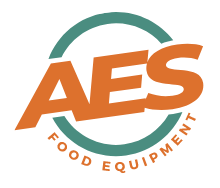Over the last 50 years, various meat rail systems have been employed to hang and transport carcass meat within meat production facilities. In this blog, we will explore these types of meat rail systems, examining the benefits and drawbacks of each, and providing recommendations on the most suitable systems for your meat processing business.
Round Bar/Tubular Systems

Round bar or tubular meat rail systems remain widely used in the UK across abattoirs, cutting plants, and butcheries. This system consists of a steel framework with galvanised metal hangers at varying heights, supporting steel tubes for meat skids and tubular roller hooks. Directional changes are managed via switches, available in 25, 45, and 90-degree turns, with newer rollover designs enhancing operator safety by preventing hooks from falling off the ends.
Commonly, the rail tubes are either 48mm or 60mm in diameter, with 60mm being prevalent in Europe. Notable manufacturers of round bar meat rail systems include Couedic Madore and Hocker. These systems can also feature pneumatic switches, allowing operators to change directions using a controller, where a ram turns over the switch.
Advantages:
- Cost-effective, using tubular galvanised tubes.
- Meat skids can double as hooks.
Disadvantages:
- Requires regular greasing for smooth hook movement.
- Potential safety issues with hooks detaching.
- Complex structural support may cause installation challenges.
Aluminium/Stainless Steel Twin Track Meat Rail Systems

Aluminium and stainless steel twin track systems are the leading meat rail systems in the UK market, due to their numerous advantages. These systems feature a steel supporting framework with hangers that clip onto I-beams, holding two single extruded track profiles. The system utilises plastic-wheeled rollers for easy carcass movement.
Various switches, including 45 and 90-degree turns, as well as 3-way or 4-way directional switches, facilitate complex operational workflows. Notable manufacturers of twin track meat rail systems include Transuni, Biralux, Abachem and AES.
Advantages:
- High safety, preventing hook dislodgment.
- Easy carcass movement due to plastic rollers with bearings.
- No need for greasing, reducing maintenance and cleaning efforts.
- Corrosion-resistant materials like aluminium and stainless steel.
- Easy to upgrade or modify without specialist machinery.
Disadvantages:
- Space requirements for installation, particularly in smaller chillers or cold rooms.
- Necessitates a supporting structure.
Flat Bar Systems
Once common in the UK, flat bar systems are now primarily used in North American meat processing facilities. These systems, supported by a steel framework, involve a flat bar where hooks with single wheels sit on top.
Advantages:
- Cost-effective.
Disadvantages:
- Lack of available flat bar switches.
- Safety concerns with hook attachment.
- Susceptibility to rust.
Self-Supporting Aluminium Rails

This modern European meat rail system integrates a self-supporting aluminium structure, simplifying design and installation. The system features plastic switches and pulls for directional changes, with hooks seated on small wheels inside the rail. Notable manufacturers of self supporting rail systems include Italmodular and Tonon.
Advantages:
- Streamlined design and installation process.
Disadvantages:
- Lower SWL (Safe Working Load) for hooks.
- Requires numerous supporting columns, impacting floor space.
- Potential operational delays due to sticking plastic components.
Choosing the Right Meat Rail System
Selecting the appropriate types of meat rail system depends on several factors: existing infrastructure, available supporting steelwork, facility size, and operational requirements. Generally, the aluminium twin track rail system is recommended for most meat processing facilities. At AES Food Equipment, we distribute leading suppliers of this rail type and can match your existing layouts.
For more information or to discuss your specific requirements, please contact us.
